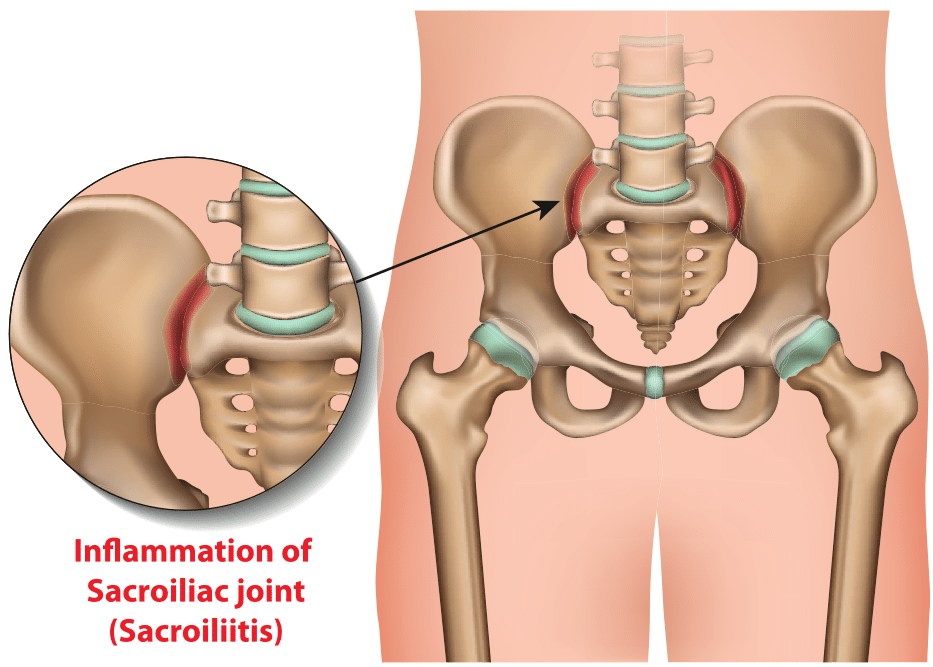What are SI joint injections?
Sacroiliac joint (SI) joint injections, are a type of injection therapy used to diagnose and treat pain related to the sacroiliac joint, which is located in the lower back where the spine meets the pelvis. The sacroiliac joint is responsible for transmitting weight and forces between the upper body and legs and is critical for normal walking and sitting.
The injection involves placing a needle into the joint and injecting a combination of a local anesthetic and anti-inflammatory medication. The injection is usually performed under live X-ray or ultrasound guidance to ensure proper needle placement and accurate delivery of medication.
SI joint injections (SIJI) are also known as sacroiliac joint injection, SI steroid injection, SI joint block, SI joint pain injection
What is the sacroiliac (SI) joint?
The sacroiliac joint is a joint in the lower back where the spine and pelvis meet. The joint is located on each side of the sacrum, which is the triangular bone at the base of the spine that forms the back of the pelvis. The sacroiliac joint is responsible for transmitting weight and forces between the upper body and legs and is critical for normal walking and sitting.
Pain related to the sacroiliac joint can occur due to a variety of factors, including trauma, arthritis, and degeneration. Symptoms of sacroiliac joint dysfunction can include lower back pain, buttock pain, hip pain, and difficulty walking or standing for long periods of time.

How do SI joint injections work?
SI joint injections work by delivering a combination of a local anesthetic and a steroid medication directly into the SI joint. The local anesthetic (such as lidocaine or bupivacaine) works to numb the joint and provide immediate pain relief. The steroid medication (such as cortisone) helps to reduce inflammation and swelling in the joint, providing longer-term pain relief.
Which conditions are treated with SI joint injections?
SI joint injections are primarily used to diagnose and treat pain related to the sacroiliac joint. Some of the conditions that may be treated with SI joint injections include:
- Sacroiliac joint dysfunction: This condition occurs when there is too much or too little movement in the sacroiliac joint, leading to pain in the lower back, buttocks, and legs.
- Arthritis: Arthritis can cause inflammation and pain in the sacroiliac joint, leading to discomfort and limited mobility.
- Trauma: A fall or other injury can cause damage to the sacroiliac joint, leading to pain and inflammation.
SI joint injections may also be used to help diagnose the source of pain in the lower back or buttocks. If the injection provides immediate pain relief, it is likely that the sacroiliac joint is the source of the pain. If the injection does not provide relief, the pain may be coming from another source.
Who performs SI joint injections?
SI joint injections are typically performed by a qualified healthcare professional, such as a pain management specialist, anesthesiologist, interventional radiologist, or physiatrist (a physician specializing in physical medicine and rehabilitation).
What can I expect during the procedure?
During an SI joint injection procedure, the patient can typically expect the following:
- Preparation: The patient will be asked to change into a hospital gown and lie face down on a procedure table. The skin around the injection site will be cleaned and numbed with a local anesthetic.
- Imaging guidance: To ensure accurate needle placement, live X-ray or ultrasound guidance may be used to locate the sacroiliac joint and guide the needle into the joint.
- Injection: A needle will be inserted into the sacroiliac joint and a combination of a local anesthetic and anti-inflammatory medication, such as a steroid, will be injected into the joint.
The entire procedure usually takes less than 30 minutes and the patient can usually go home the same day.
Is it painful?
The procedure may cause some discomfort or pain, but most people tolerate it well with the help of local anesthesia and sedation.
How long does an SI joint injection take to complete?
A facet joint injection procedure typically takes about 15-30 minutes to complete
What is the recovery time after the procedure?
Most people can resume their normal activities within a day or two of the procedure.
You may experience some mild discomfort or soreness at the injection site for a few days, and your healthcare provider may recommend that you avoid strenuous activities or heavy lifting during this time.
Returning to work after an SI joint injection procedure will depend on the nature of your job and the level of physical activity involved. If your job involves minimal physical activity and you feel comfortable, you may be able to return to work the day after the procedure. However, if your job involves heavy lifting or other strenuous activity, you may need to take a few days off to allow for adequate recovery.
How long does an SI joint injection take to work?
Some people may experience immediate pain relief, while others may take several days to a week to feel the full effects of the injection.
How long do the effects last?
In general, the effects of facet joint injections can last from several weeks to several months.
What are the risks?
As with any medical procedure, there are risks associated with SI joint injections. However, the risks are generally low and the procedure is considered safe for most people. Some of the potential risks of facet joint injections include:
- Infection: There is a risk of infection at the injection site, although this is rare. Proper sterilization techniques are used to minimize this risk.
- Bleeding: There is a small risk of bleeding, particularly in people who are taking blood-thinning medications.
- Allergic reaction: In rare cases, people may experience an allergic reaction to the medication used in the injection.
- Nerve damage: There is a small risk of nerve damage during the injection, which can cause numbness, tingling, or weakness in the affected area.
It’s important to discuss the risks and benefits of SI joint injections with your healthcare provider before the procedure. If you experience any unusual symptoms or complications after the injection, you should contact your healthcare provider right away.
Do SI injections work?
Studies have shown up to an 80% improvement in pain and disability following SI joint injection (Slipman 2001). The North American Spine Society (NASS) has taken the position that intra-articular steroid joint injections may be considered in patients with suspected SI joint pain.
Are SI injections right for me?
SI joint injections may be recommended if you have chronic back or SI pain that has not responded to other treatments, such as physical therapy, medication, or rest. They may also be recommended as a diagnostic tool to help pinpoint the exact source of your pain.
It’s important to discuss the risks and benefits of the procedure with your healthcare provider to determine if it is an appropriate treatment option for you.
References
Slipman, C W et al. “Fluoroscopically guided therapeutic sacroiliac joint injections for sacroiliac joint syndrome.” American journal of physical medicine & rehabilitation vol. 80,6 (2001): 425-32.
